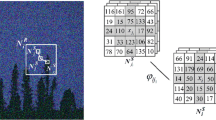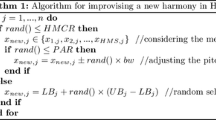Abstract
Multi-objective optimization problems require the simultaneous optimization of more than one objective function. Image segmentation algorithm partitions an image into different parts according to its features and properties. It is essentially a multi-objective optimization problem because of multiple requirements. Multi-objective evolutionary fuzzy clustering (MOEFC) algorithms behave much better than traditional fuzzy clustering algorithms due to considering several cluster indices and automatically determining the number of clusters. When applied to image segmentation, MOEFC algorithms generally consume a long running time and cannot well preserve the region-level information in images. To solve these problems and meanwhile utilize some prior information derived from images to further improve the performance of MOEFC algorithms, this paper proposes a multiple population-based multi-objective evolutionary semi-supervised multi-kernel region fuzzy clustering image segmentation. First, effective region features considering color, texture and spatial information are extracted. Next, region-level-based semi-supervised fitness functions are designed using the obtained region features and some propagation supervision information. Further, in order to effectively aggregate image features, the constructed fitness functions are extended to a non-linear version utilizing a multi-kernel function. Then, a multi-population evolutionary strategy is adopted to improve the diversity of population. Except for the traditional crossover and mutation operators, the recombination operator between two populations and a center updating based elitist strategy are designed. Finally, a multiple kernel evaluation index with region information and propagation supervision information is constructed to select an optimal solution from the non-dominant solution set. Experimental results on several image datasets show that the proposed algorithm outperforms state-of-the-art methods in segmentation performance and running efficiency.




















Similar content being viewed by others
Availability of data and material
In this paper, twenty images are selected from Berkeley Segmentation Dataset, five synthetic images which are created by the Describable Textures Dataset (DTD) and five real images which are chosen from the UC Merced Land Use datasets.
References
Garcia-Lamont F, Cervantes J, Lopez A, Rodriguez L (2018) Segmentation of images by color features: a survey. Neurocomputing 292:1–27
He L, Huang S (2017) Modified firefly algorithm based multilevel thresholding for color image segmentation. Neurocomputing 240:152–174
Xue J, He X, Yang X, et al. (2017) Multi-threshold image segmentation method based on flower pollination algorithm. In: International conference on bio-inspired computing: theories & applications. Springer, Singapore, pp. 39–51
Zhao F, Fan JL, Liu HQ et al (2019) Noise robust multi-objective evolutionary clustering image segmentation motivated by intuitionistic fuzzy information. IEEE Trans Fuzzy Syst 27(2):387–401
Ortiz A, Gorriz JM, Ramirez J, Salasgonzalez D (2014) Improving MR brain image segmentation using self-organising maps and entropy-gradient clustering. Inf Sci 262:117–136
Grau V, Mewes AU, Alcaniz M et al (2004) Improved watershed transform for medical image segmentation using prior information. IEEE Trans Med Imaging 23(4):447–458
Bensaid A, Hall LO, Bezdek JC et al (1996) Validity-guided (re)clustering with applications to image segmentation. IEEE Trans Fuzzy Syst 4(2):112–123
Bezdek JC (1981) Pattern recognition with fuzzy objective function algorithms. Plenum Press, New York
Hathaway RJ, Huband JM, Bezdek JC, et al. (2005) Kernelized non-Euclidean relational fuzzy c-means algorithm. In: Proceeding of the 14th IEEE international conference on fuzzy systems, Reno, USA, pp. 414–419
Wu Y, Ma W, Gong M et al (2015) Novel fuzzy active contour model with kernel metric for image segmentation. Appl Soft Comput 34:301–311
Chen L, Chen CL, Lu M et al (2011) A multiple-kernel fuzzy c-means algorithm for image segmentation. IEEE Trans Syst Man Cybern B Cybern 41(5):1263–1274
Hu G, Du Z (2019) Adaptive kernel-based fuzzy c-means clustering with spatial constraints for image segmentation. Int J Pattern Recognit Artif Intell 33(01):1954003
Graves D, Pedrycz W (2010) Kernel-based fuzzy clustering and fuzzy clustering: a comparative experimental study. Fuzzy Sets Syst 161(4):522–543
Yu CY, Li Y, Liu AL, et al. (2011) A novel modified kernel fuzzy c-means clustering algorithm on image segmentation. In: Processing of 14th IEEE international conference on computational science and engineering, Dalian, China, pp. 621–626
Wang L (2022) Imbalanced credit risk prediction based on SMOTE and multi-kernel FCM improved by particle swarm optimization. Appl Soft Comput 114:108153
Tan DY, Peng X, Wang Q et al (2021) Automatic determining optimal parameters in multi-kernel collaborative fuzzy clustering based on dimension constraint. Neurocomputing 443:58–74
Yasunori E, Yukihiro H, Makito Y, et al. (2009) On semi-supervised fuzzy c-means clustering. In: IEEE international conference on fuzzy systems, Jeju Island, South Korea, pp. 1119–1124
Son LH, Tuan TM (2017) Dental segmentation from X-ray images using semi-supervised fuzzy clustering with spatial constraints. Eng Appl Artif Intell 59:186–195
Zheng J, Zhou Y, Deng T et al. (2017) A self-trained semi supervised fuzzy clustering based on label propagation with variable weights. In: 29th Chinese control and decision conference (CCDC), Chongqing, China, pp. 7447–7452
Zhang D, Tan K, Chen S et al (2004) Semi-supervised kernel-based fuzzy c-means. In: Pal NR, Kasabov N, Mudi RK, Pal S, Parui SK (eds) International conference on neural information processing. Springer, Berlin, pp 1229–1234
Mai SD, Ngo LT (2018) Multiple kernel approach to semi-supervised fuzzy clustering algorithm for land-cover classification. Eng Appl Artif Intell 68:205–213
Cheng R, Ding JL, Du WL (2022) Thematic issue on knowledge and data driven evolutionary multi-objective optimization. Memetic Comput 14:133–134
Ma HP, Wei HY, Tian Y et al (2021) A multi-stage evolutionary algorithm for multi-objective optimization with complex constraints. Inf Sci 560:68–91
Handl J, Knowles JD (2007) An evolutionary approach to multiobjective clustering. IEEE Trans Evol Comput 11(1):56–76
Mukhopadhyay A, Maulik U (2011) A multiobjective approach to MR brain image segmentation. Appl Soft Comput 11(1):872–880
Zhao F, Liu HQ, Fan JL (2015) A multiobjective spatial fuzzy clustering algorithm for image segmentation. Appl Soft Comput 30:48–57
Zhao F, Zhang MM, Liu HQ (2019) Multi-objective evolutionary semi-supervised fuzzy clustering image segmentation motivated by region information. J Electron Inf Technol 41(5):1106–1113
Li Z & Chen J (2015) Superpixel segmentation using linear spectral clustering. In: 2015 IEEE conference on computer vision and pattern recognition (CVPR), Boston, USA, pp. 1356–1363
Tong Y, Chen R, Cheng Y et al (2014) Facial expression recognition algorithm using LGC based on horizontal and diagonal prior principle. Optik 125(16):4186–4189
Zhao Z, Liu B, Zhang C et al (2019) An improved adaptive NSGA-II with multi-population algorithm. Appl Intell 49(2):569–580
Deb K, Agrawal S, Pratap A et al (2002) A fast and elitist multiobjective genetic algorithm: NSGA-II. IEEE Trans Evol Comput 6(2):849–858
Zhang H, Fritts JE, Goldman SA (2008) Image segmentation evaluation: a survey of unsupervised methods. Comput Vis Image Underst 110(2):260–280
Arbelaez PA, Maire M, Fowlkes CC et al (2011) Contour detection and hierarchical image segmentation. IEEE Trans Pattern Anal Mach Intell 33(5):898–916
Cimpoi M, Maji S, Kokkinos I, et al. (2014) Describing textures in the wild. In: 2014 IEEE conference on computer vision and pattern recognition, Columbus, USA, pp. 3606–3613
Yang Y, Newsam S (2010) Bag-of-visual-words and spatial extensions for land-use classification. In: ACM SIGSPATIAL international conference on advances in geographic information systems, San Jose California, pp. 270–279
García S, Fernández A, Luengo J, Herrera F (2010) Advanced nonparametric tests for multiple comparisons in the design of experiments in computational intelligence and data mining: experimental analysis of power. Inf Sci 180(10):2044–2064
Funding
This study was funded by the National Natural Science Foundation of China (Grant Nos. 62071379 and 61571361).
Author information
Authors and Affiliations
Contributions
FZ: Conceptualization, Methodology, Writing- Original draft preparation, Writing- Reviewing and Editing. MZ: Data curation, Software, Visualization. HL: Methodology, Visualization, Investigation, Supervision.
Corresponding authors
Ethics declarations
Conflict of interest
The authors declare that they have no known competing financial interests or personal relationships that could have appeared to influence the work reported in this paper.
Additional information
Publisher's Note
Springer Nature remains neutral with regard to jurisdictional claims in published maps and institutional affiliations.
Rights and permissions
Springer Nature or its licensor (e.g. a society or other partner) holds exclusive rights to this article under a publishing agreement with the author(s) or other rightsholder(s); author self-archiving of the accepted manuscript version of this article is solely governed by the terms of such publishing agreement and applicable law.
About this article
Cite this article
Zhao, F., Zhang, M. & Liu, H. Multiple population-based multi-objective evolutionary semi-supervised multi-kernel region fuzzy clustering image segmentation. Memetic Comp. 15, 451–468 (2023). https://doi.org/10.1007/s12293-023-00396-x
Received:
Accepted:
Published:
Issue Date:
DOI: https://doi.org/10.1007/s12293-023-00396-x




